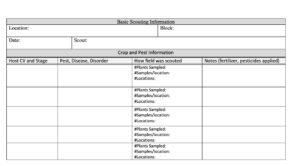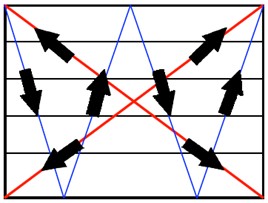The Tools:
- Hand lens-10x or 15x -To correctly use a hand lens, place the lens directly in front of your eye and bring the sample you are examining towards the lens until the object comes into focus.
- Knife – good for cutting into stems or root tissue.
- Pruning shears- for taking samples – disinfest blades between samples to avoid spreading disease.
- A soil sampling tube, spade and/or trowel to sample soil or examine roots.
- Newspaper or plastic bags for samples/indelible marker- individually marking bags with information as the samples are collected makes it easier to keep information straight about what pests were found in particular locations.
- Notebook or clipboard with record-keeping sheets. Plastic sheet protectors can be used to protect records and maps. Maps can also be laminated to prolong their useful life.
- Digital camera or phone to document the scene, focusing on any areas of interest that can’t be collected.
Why Scout?
Pathogens, insects, weeds and other pests negatively impact ornamental plant production (greenhouse, nursery, landscape). Integrated pest management (IPM) strategies are used to prevent (ideally) or mitigate damage to ornamental crops. IPM strategies of ornamentals include practices such as proper plant choice for the site, incorporation of resistant varieties when available, the use of pesticides to manage problems, and an acceptance that certain levels of damage may be necessary. Unlike insect or weed pests, integrated disease management (IDM) has a very low economic threshold—a single lesion may contain thousands to millions of spores or bacteria. Under conducive environmental conditions, the inoculum in a single lesion can spread and initiate thousands of new infections. The goal of IDM is to prevent those lesions from forming in the first place. Early detection, sanitation and eradication improve overall disease management and are a foundation for good plant health management.
Scouting is the foundation of any IDM program. Scouting consists of systematically moving through the nursery, greenhouse or landscape looking for pathogens and pests, quantifying damage and evaluating thresholds. Scouting allows for the early identification of potential problems, providing more management options that can be implemented prior to a critical threshold, thereby reducing the control costs and crop losses. Since pest and pathogen populations vary, spraying without scouting (or spraying and praying) first may result in unnecessary or insufficient pesticide applications. A grower can use pesticides more effectively by knowing what pathogens are in an orchard, vineyard, or berry patch, anticipating problems, and treating them before significant damage and losses result.
How to scout
There are innumerable pests (insects, diseases, and weeds) common to every fruit crop. All of these can and should be monitored by field scouting.
When scouting for pathogens or pests, it is important to get a random sample. However, the scout also needs to observe and note any high population areas (foci) in the field. Scouts should walk through the field in a “V,” “X,” or “W” pattern to get a random sample of pest populations within the field. Anywhere from 25-100 plants should be randomly selected for examination, depending on the size of the operation.
Random selection of plants is the key to an accurate indication of a pest or pathogen population. This doesn’t mean ignoring problems that you might see while scouting that don’t conform to your pattern! Remember the goal is to identify any problems early, not walk in a pattern.
Stick to scouting patterns while noting any areas of unusual plants or problems [e.g., areas of high pathogen or pest population, called focus areas or foci (plural)]. Take care to prevent insect or pathogen foci from skewing the results—these areas may warrant separate treatment plans, eradication, or additional applications of pesticide.
Scouting patterns. Remember The goal is to quickly identify problems! Image source unknown.
Where to scout:
Scouting is different for each fruit crop. In an orchard, scouting should begin in the late winter, while pruning, to identify any canker problems (Fig. 1), like fire blight, Botryosphaeria canker or crown gall (Table 1). When examining individual plants, observe the top, middle, and bottom canopy. For young plants, give a firm tug to assess rooting establishment (don’t go all Terminator on them, though!). Healthy, well-established plants remain anchored while those with root rots will pop out of lighter, sandy soils. In a vineyard, scouting should also begin with late winter pruning, carefully observing cordons for damage or cankers, and the crown for crown gall. Strawberries crown should be examined closely to make sure any crown rot infected plants are removed.
Prune out and discard any obviously infected plants, or entire plants. These plants are more likely to serve as the start of an epidemic rather than provide a yield. Continue scouting paying extra attention at bud break to catch diseases early, before losses compound.

Figure 1. Bacterial canker on cherry should be identified and removed with spring pruning. Photo by George Sundin, MSU.
Table 1. Host, location and problem to scout during dormant season.
| Host | Location | Primary Problem to Scout |
| Apple, Pear | Branches | Fire blight, black rot, white rot, |
| Crown | Phytophthora | |
| Peach | Branches | Cytospora canker, brown rot cankers |
| Cherry | Branches | Bacterial canker, Cytospora, black knot (rarer) |
| Plum | Branches | Black knot, Cytospora |
| All Stone Fruit | Crown | Phytophthora |
| Grape | Cordons | Black rot, Eutypa, Botryosphaeria cankers, |
| Crown | Crown gall | |
| Blueberry | Branches | Phomopsis, Botryosphaeria canker, Fusicoccum canker |
| Crown | Phytophthora | |
| Bramble | Canes | Anthracnose cankers, spur blight |
| Crown | Crown gall | |
| Strawberry | Plant | Entire plant for winter injury, |
When scouting the wider orchard, vineyard or berry patch, consider the geography, including prevailing winds and rains, and field orientation (e.g., buildings or large trees that serve as windbreaks that increase humidity; corn/bean fields that may drift herbicide or serve as sources of white mold (Sclerotinia sclerotiorum) that can cause problems in strawberries, etc. Note any low spots that tend to accumulate water (depressions in fields or leaks in irrigation).
Table 2: Early season disease problems to scout for
| Host | Location | Primary Problem to Scout |
| Apple, Pear | Branches | Apple scab, powdery mildew |
| Peach | Branches | Taphrina, brown rot |
| Cherry | Branches | Bacterial canker, black knot, brown rot |
| Plum | Branches | Plum pockets, Black knot |
| Grape | Cordons | Black rot, Phomopsis |
| Blueberry | Branches | Phomopsis, |
| Bramble | Canes | Anthracnose cankers |
| Strawberry | Plant | Anthracnose, botrytis |
When to Scout:
Disease scouting should begin as soon as planting or budbreak and continue throughout the entire growing season.
Draw a map of your orchard, vineyard or berry patch, to identify blocks/cultivars and problems areas from year to year. This is particularly important as many cultivars are uniquely susceptible to specific diseases (e.g., Honeycrisp apple and bitter rot; vinifera grapes and powdery mildew; Chandler strawberry and anthracnose) and diseases are best controlled early in the season before symptoms are visible (Table 2). Waiting for symptoms to appear to begin fungicide applications can result in severe damage and losses to all fruit crops in the Midwest. By incorporating scouting, and using survey information to plan treatments, disease problems can be managed proactively and efficiently.
Should an unknown problem be found, samples can be sent to the Purdue Plant and Pest Diagnostic office (www.purdue.edu/PPDL) for identification and management suggestions.
Record Keeping
As an IDM tool, scouting is only one the first part of IDM. Without proper records, scouting will be ineffective. An example scouting template example can be seen on the last page (Fig. 2). The greatest value derived from scouting is the record of what plants have problems and when they occur so you can be proactive in future years and prevent these problems from happening and share this information with anyone else also working in your operation. The best way to do this is to keep and regularly review detailed records. Records and maps provide a history of past problems and provide a leg-up on future diagnoses, showing where, when and what crops have had problems. Information should be compiled weekly and then examined at the end of the season to prepare for next year’s scouting and disease management.
When performed proactively, IPM saves growers money on chemical costs and reduces losses. It is the difference between planning and being proactive versus responding reactively to big losses. Developing a new IPM routine is hard and requires effort and intention. Begin by blocking a regular time to scout every week and allow time to record your efforts. Recognize that other demands in the greenhouse and/or nursery will compete with this time, so prioritize it by setting an alarm in your phone or setting up a team approach so it isn’t the responsibility of just one person. Keep in mind that this is process that will require repeated practice, but it is one that will pay dividends in better plant health and a better bottom line.

Figure 2. Example scouting template. Start getting into the scouting habit by keeping it simple. As scouting becomes a habit, expand what you scout and when you scout it, improving your process as you gain experience. Use these notes next year to know where to look for problems, or to focus on sanitation and heightened management to prevent future problems.
